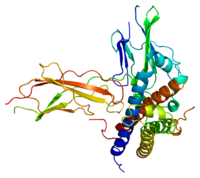
Photo from wikipedia
Summary Characterization of ancestry-linked peptide variants in disease-relevant patient tissues represents a foundational step to connect patient ancestry with disease pathogenesis. Nonsynonymous single-nucleotide polymorphisms encoding missense substitutions within tryptic peptides… Click to show full abstract
Summary Characterization of ancestry-linked peptide variants in disease-relevant patient tissues represents a foundational step to connect patient ancestry with disease pathogenesis. Nonsynonymous single-nucleotide polymorphisms encoding missense substitutions within tryptic peptides exhibiting high allele frequencies in European, African, and East Asian populations, termed peptide ancestry informative markers (pAIMs), were prioritized from 1000 genomes. In silico analysis identified that as few as 20 pAIMs can determine ancestry proportions similarly to >260K SNPs (R2 = 0.99). Multiplexed proteomic analysis of >100 human endometrial cancer cell lines and uterine leiomyoma tissues combined resulted in the quantitation of 62 pAIMs that correlate with patient race and genotype-confirmed ancestry. Candidates include a D451E substitution in GC vitamin D-binding protein previously associated with altered vitamin D levels in African and European populations. pAIMs will support generalized proteoancestry assessment as well as efforts investigating the impact of ancestry on the human proteome and how this relates to the pathogenesis of uterine neoplasms.
Journal Title: iScience
Year Published: 2022
Link to full text (if available)
Share on Social Media: Sign Up to like & get
recommendations!